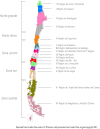Birth cultures: A qualitative approach to home birthing in Chile
- PMID: 33886560
- PMCID: PMC8062023
- DOI: 10.1371/journal.pone.0249224
Birth cultures: A qualitative approach to home birthing in Chile
Abstract
Background: Birth cultures have been transforming in recent years mainly affecting birth care and its socio-political contexts. This situation has affected the feeling of well-being in women at the time of giving birth.
Aim: For this reason, our objective was to analyse the social meaning that women ascribe to home births in the Chilean context.
Method: We conducted thirty semi-structured interviews with women living in diverse regions ranging from northern to southern Chile, which we carried out from a theoretical-methodological perspective of phenomenology and situated knowledge. Qualitative thematic analysis was used to analyse the information collected in the field work.
Findings: A qualitative thematic analysis produced the following main theme: 1) Home birth journeys. Two sub-categories: 1.1) Making the decision to give birth at home, 1.2) Giving birth: (re)birth. And four sub-categories also emerged: 1.1.1) Why do I need to give birth at home? 1.1.2) The people around me don't support me; 1.2.1) Shifting emotions during home birth, 1.2.2) I (don't) want to be alone.
Conclusion: We concluded that home births involve an intense and diverse range of satisfactions and tensions, the latter basically owing to the sociocultural resistance surrounding women. For this reason, they experienced home birth as an act of protest and highly valued the presence of midwives and their partners.
Conflict of interest statement
The authors have declared that no competing interests exist.
Figures
References
-
- Mead M. Sex and Temperament in Three Primitive Societies. Michigan: Routledge & Sons; 1935
-
- Olza I. Parir. El poder del parto. Barcelona: Ediciones B; 2017
-
- Sánchez-Rivera M. Construcción social de la maternidad: El papel de las mujeres en la sociedad. Opción. 2016;32(13): 921–953. Available from https://www.redalyc.org/pdf/310/31048483044.pdf
-
- Castoriadis C. L’institution imaginaire de la societé. Paris: Editions de Seuil; 1975




